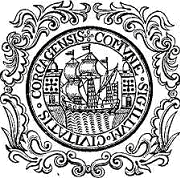Cork City
CORK, a sea-port, city, and a county of itself, and the head of a diocese, locally in the county of CORK, of which it is the capital, and in the province of MUNSTER, 51 miles (S. W. by W.) from Waterford, and 126 (S. W. by S.) from Dublin; containing 107,007 inhabitants, of which number, 84,000 are in the city and suburbs. This place, which in extent and importance is the second city in Ireland, and is distinguished for its fine harbour, derived its ancient names Corcach and Corcach-Bascoin, signifying in the Irish language "a marshy place," from its situation on the navigable river Lee. The earliest authentic account of its origin occurs in Colgan's life of St. Nessan, to whose preceptor, St. Barr or Finbarr, is attributed the foundation of a cathedral church, to which, as the abode of that saint, such numbers of disciples resorted from all parts, that the desert in which it stood soon became the site of a considerable city. St. Nessan, according to the annals of the four masters, died in 551: if this be correct, he could not be a disciple of St. Finbarr, unless the latter flourished at a period much earlier than that stated by Sir James Ware, namely, about the year 630. The original city was built on a limestone rock, on the margin of the south branch of the river, and appears to have grown up around the cathedral and westward as far as the monastery called Gill Abbey; but what from a very early period has been more especially regarded as the city was erected on the island formed by the Lee, and its origin is ascribed to the Danes, who, after repeatedly plundering the old city and its religious establishments for more than 300 years, settled here in 1020, but did not long retain possession, being eighteen years afterwards defeated with great slaughter, and the whole of their property destroyed by fire. In 1080 the city is said to have been destroyed by lightning; and eight years afterwards the Danes of Dublin, Waterford, and Wicklow united their forces to recover possession of it, but were defeated by a large body of the natives of Oneachach, now forming the district of West Carbery. According to other accounts, Dermot, the son of Foirdhealbhach O'Brien, in the same year, laid waste and plundered the town, and carried away the relics of St. Finbarr.
51 miles (S. W. by W.) from Waterford, and 126 (S. W. by S.) from Dublin; containing 107,007 inhabitants, of which number, 84,000 are in the city and suburbs. This place, which in extent and importance is the second city in Ireland, and is distinguished for its fine harbour, derived its ancient names Corcach and Corcach-Bascoin, signifying in the Irish language "a marshy place," from its situation on the navigable river Lee. The earliest authentic account of its origin occurs in Colgan's life of St. Nessan, to whose preceptor, St. Barr or Finbarr, is attributed the foundation of a cathedral church, to which, as the abode of that saint, such numbers of disciples resorted from all parts, that the desert in which it stood soon became the site of a considerable city. St. Nessan, according to the annals of the four masters, died in 551: if this be correct, he could not be a disciple of St. Finbarr, unless the latter flourished at a period much earlier than that stated by Sir James Ware, namely, about the year 630. The original city was built on a limestone rock, on the margin of the south branch of the river, and appears to have grown up around the cathedral and westward as far as the monastery called Gill Abbey; but what from a very early period has been more especially regarded as the city was erected on the island formed by the Lee, and its origin is ascribed to the Danes, who, after repeatedly plundering the old city and its religious establishments for more than 300 years, settled here in 1020, but did not long retain possession, being eighteen years afterwards defeated with great slaughter, and the whole of their property destroyed by fire. In 1080 the city is said to have been destroyed by lightning; and eight years afterwards the Danes of Dublin, Waterford, and Wicklow united their forces to recover possession of it, but were defeated by a large body of the natives of Oneachach, now forming the district of West Carbery. According to other accounts, Dermot, the son of Foirdhealbhach O'Brien, in the same year, laid waste and plundered the town, and carried away the relics of St. Finbarr.
